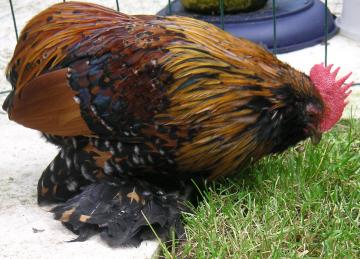
Overview
The Belgian d’Everberg, otherwise known as the Bearded Everberg or Barbu d’Everberg, is a bantam breed of chicken that is the tailless version of the Barbu d’Uccle, that was developed in Everberg in Belgium a municipality of Kortenberg, by Robert Pauwels. Thought to have been created by breeding the Barbu d’Uccle with another tailless breed in 1906.
It has no standardized chicken counterpart for this breed and it is considered one of the most endangered chickens in Belgium, with its conservation status listed as critical. The Belgian d’Everberg a true bantam.
The males weigh 1.5-1.7lbs (700-800g) and the females weigh 1.2-1.4lbs (550-650g).
Eggs
Size
Small sized eggs
Color
White colored eggs
Production per year
100 eggs per annum
When do they start laying eggs?
From 6 months
Bearded d’Uccle Characteristics
Temperament / Are they good as pets?
Very calm and friendly birds, perfect for those with kids
How do I tame Bearded d’Uccle chickens?
Feed them out of your palm to tame them, you can also pick them up so they get used to human contact.
How many do I need to buy?
At an absolute minimum you need 2 chickens, however, 3+ would be best.
How much space do they need?
Can be kept in a run, which needs 25 square feet per chicken.
Will they mix with my other chickens?
Yes, they’re calm and shouldn’t have any problems integrating. However problems ive found arise when there is a clear size difference between the new hen and the existing ones. The larger hens can bully the more docile smaller hens.
Appearance
The Belgian d’Everberg is a tailless version of the Bearded d’Uccle. The most popular color of plumage is Millefleur. They have feathered legs that may need some attention to stop them becoming matted. They have a straight comb and red earlobes.
Feeding
What should I feed them?
At first after they hatch they should be fed a fine version of chicken feed called growers mash which has everything they need to grow big and strong as well as a 19{cfcd481556a8b43fba6af451761032bd323e94372a0c1e607} protein content.
At 6 weeks they can start eating chicken pellets which has roughly 15-16{cfcd481556a8b43fba6af451761032bd323e94372a0c1e607} protein.
When your chickens reach 18 weeks you need to switch their food to growers mash or growers pellets, this will support your chickens with egg production by giving them everything the need for the process, this typically has 16{cfcd481556a8b43fba6af451761032bd323e94372a0c1e607} protein. Specific chicken feed pellets for Bantams would be my recommendation here they are generally called bantam pellets and are essentially smaller pellets than the normal layers pellets.
How much should I feed them?
Because this breed is a bantam breed and therefore a lot smaller than a standard sized chicken, they need less feed than an average chicken.
Start by feeding them 2oz (60g) a day and then change this amount depending on how much of this they eat.
You can either feed them morning and evening but most people leave feed in the feeder for the chickens to eat whenever they please.
What can’t they eat?
Food that has gone moldy should not be given to chickens, the mold contains bad bacteria which can cause health issues if eaten. Because of this in the UK it’s actually against the law to feed your chickens any leftover scraps from your table.
Chocolate should definitely not be given to chickens as it has theobromine in which is deadly. The Phytohemagglutinin in beans is also fatal for chickens if consumed so make sure to not feed them this.
What do I need to keep chickens?
A chicken coop is vital if you intend to keep chickens. You’ll need a perch for each of the chickens to get some beauty sleep inside and also some laying boxes for the hens which should be filled with wood shavings.
Your coop should be around 1.1m2 or 11 square feet per chicken and the run, which they need for exercise, should have around 25 square feet per chicken.
It is really important that you have a fence to keep your chickens safe at night, this should be sunk at least 8 inches into the ground and go around and over the whole coop. As they’re small birds make sure there are no gaps in the fence they can get through. Grit is really important in egg production so make sure there is always some which they can help themselves to.
Water should also always be accessible to your chickens, try and keep it out of the sun as if the water gets too warm they won’t drink it. To stop your water getting contaminated make sure the container can’t be trodden in to and try and get a sturdy container that they can’t push over.
